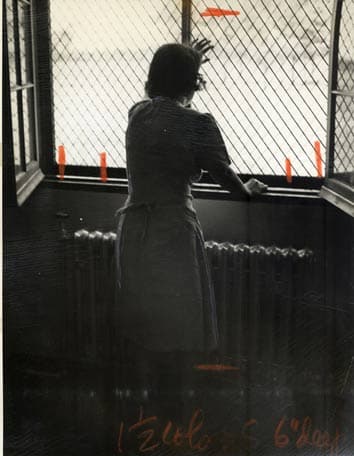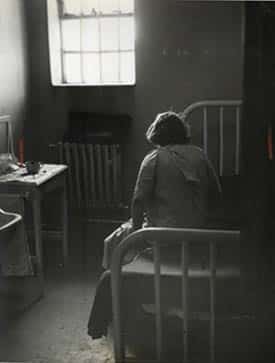by Jeannie Ludlow
“You know, illegal abortions aren’t all bad.” A few years ago, I found myself saying this to students in an Introduction to Women’s Studies course.
We were reading Marge Piercy’s 2005 novel, Sex Wars, set in post-Civil War New York City. The novel traces the careers of Elizabeth Cady Stanton, Victoria Woodhull and Anthony Comstock in the 1870s. The students had just read the section of the novel in which Comstock, the vice officer, sets up a sting and arrests Madame Restell, the notorious abortionist, in her palatial 52nd Street mansion. During the sting, Comstock pretends to be inquiring into Restell’s services for a “lady in need.” When he asks about the safety of the abortion operation, Restell answers, “I’ve lost only one patient in forty years of practice. There’s not a doctor in Manhattan who can match that record.”
One of the students asked, “Is abortion legal at this time?” I explained that no, it was not. The student frowned. “Then why didn’t Piercy write about all the women that Restell killed?”
I was puzzled. “Women she killed?” I asked.
“Yeah,” another student said, “doing illegal abortions.”
Then I got it. My students were unable to imagine the possibility of safe illegal abortions. Having been raised in the post-Roe era, their perception was that legal abortion is automatically safe and illegal abortion is, by definition, deadly. My own role as an abortion care worker — a dozen years as an abortion patient advocate, and positions on the national boards of NARAL and the Abortion Conversation Project— underscores the need for legal abortion in the U.S. today. At the same time, I am committed to remembering and teaching a more complete history of reproductive politics, one that acknowledges that safety has not always been guaranteed by legality.
Of Preventive Powders and Female Monthly Pills
Madame Restell, born Ann Trow, immigrated from England to New York City in 1831. By 1839, Ann Trow Summers Lohman had adopted the pseudonym she would use for the rest of her life and was advertising to “married women” a “simple, easy, healthy, and certain remedy” to families that “increase [in size] beyond” the ability of the parents to support them: “preventive powders” and “female monthly pills.” Before the end of 1839, Lohman had been arrested for the first time for attempting to procure an abortion. Lohman’s tenure as Madame Restell, “the wickedest woman in New York”, lasted nearly 40 years. In that time, she reputedly helped hundreds of women control their fertility. The daughter of a mill laborer, Lohman moved quickly into the upper-middle class in mid-1800s, where her notoriety seemed to be inspired as much by her class mobility as by her vocation.
When we focus our 21st century abortion rights activism exclusively on the threats to legal access to abortion, we risk losing our history of the initial criminalization of abortion. Abortion has been widely practiced — and legal — for much of human history. The criminalization of abortion in the U.S. was related more closely to changes in education of medical practitioners than to changes in popular attitudes about abortion. Until the mid-1800s in the United States, abortion was either a legal or a nonregulated practice controlled mostly by women. Pregnancy was legally and socially determined by quickening, which is when a pregnant woman first feels fetal movement.
Midwives and kinswomen provided reproductive health care for women — from attending childbirth to helping them restart “blocked” menstruation and end pregnancies that were “not right.” The American Medical Association (AMA), established in 1847 to represent the all-male college-educated physicians, stepped into this women’s realm, insisting that formally educated doctors knew better than women how to determine pregnancy and how to take care of pregnant bodies. By the late 1800s, partially in response to strong campaigning by the AMA, all states had laws on the books that criminalized abortion. Historian Rickie Solinger notes that it would be decades, however, before these laws were uniformly enforced.
| The loss of history limits our imagination of how things could be |
My students’ inability to imagine safe illegal abortion might be considered a great success for those of us who work as activists for abortion rights. After all, we’ve dedicated a lot of energy to describing the risks of recriminalizing abortion. In that class, I had assigned Jane Gillooly’s 1994 documentary, Leona’s Sister Gerri, which tells the story of Gerri Twerdy Santoro, the photo of whose body lying facedown on a motel room floor has come to represent the dangers of illegal abortion. No one could argue that my students took legal abortion for granted.
But I realized that abortion rights advocates of my generation may be failing to share an important aspect of our history — the extralegal care of women’s health, often in the face of legal obstacles. These are the stories of midwifery, women’s resistance to the institutionalization of health care, both in the 1860s-70s and in the 1960s-70s, and women’s access to self-care today.
Putting History to Work Today
I certainly do not think that criminalization was a benign state to which we should return. But I am interested in rethinking the way that we describe the history of “illegal abortion” in the U.S. in order to develop better strategies for talking about the power of women’s activism.
What if, for instance, we are more careful to distinguish among the many different kinds of illegal abortion in the U.S.? Certainly, we want to maintain strong criticism of “back alley” providers, those illegal abortion providers, historically and today, who have exploited women economically and sometimes abused women sexually. At the same time, we shouldn’t ignore the differences between those abusive illegal abortion providers and reputable extralegal providers like Madame Restell in the 19th century and Ruth Barnett in the 20th. Barnett, the subject of historian Rickie Solinger’s book The Abortionist, provided safe and effective extralegal abortion to women on the west coast from 1918 through 1968. Solinger is careful to note that Barnett is but one example of many reputable extralegal providers active in the U.S. until the Supreme Court legalized abortion in 1973.
Also lost is the work of abortion referral services in the mid-20th century. Many major cities in the U.S. had “abortion referral services” that helped pregnant women find the best illegal abortions they could afford. Perhaps the most famous of these is “Jane,” the Chicago Women’s Liberation Union abortion service that gradually became a provider service at a time when abortion was still illegal. Daniel Maguire’s book and documentary film, both titled Sacred Choices and Abortion, reveal that these services were sometimes provided by clergymen of all denominations from rabbis to priests to pastors. Nearly 40 years after legalization, in the wake of the so-called “abortion wars,” it is hard to imagine Baptist ministers and Catholic priests vetting illegal providers before providing contact information to pregnant women. The loss of this history of activist religious professionals limits not only our knowledge of yesterday, but our imagination of how things could be today.
The entire history of safe, extralegal abortions could provide new ways to think about abortion today. Currently, the pro-choice movement tends to assume that all abortion providers are doctors. In this way, we erase the important work of clinic founders, owners, CEOs and managers, many of whom are feminist businesspersons. Like Madame Restell, these providers have developed their commitment to women’s rights into high-quality medical care, creating careers for themselves and their employees in the process. We also tend to speak of all abortion doctors as heroes and we seem to have lost the willingness, or ability, to evaluate providers’ commitment to patient care and safety.
I propose that we look again at illegal, extralegal, and legal abortion and reshape our understanding to focus on the difference between harmful, exploitive practices and safe, compassionate care. We need to think about how we might damn, in the strongest sense of the word, those providers — now and in the past — who hurt, assaulted or killed women, and who preyed on pregnant women’s vulnerabilities and fears. At the same time, I want us to teach the next generation to honor providers of all eras and roles who used care and safe practices, in violation of the law when necessary, to protect women’s health and dignity, before that part of women’s health history is lost.
Jeannie Ludlow is Assistant Professor of English and Coordinator of Women’s Studies at Eastern Illinois University, a former abortion clinic employee, Secretary of the Board of the Abortion Conversation Project and a member of the national board of NARAL.
Also see: Letter to a Young Activist: Don’t Drop the Banner by Barbara Santee in this edition of On The Issues Magazine
Also see: As Access Slides, “Extract” From Our Self-Help Past by Carol Downer in this edition of On The Issues Magazine
Read the Cafe for new and updated stories.


